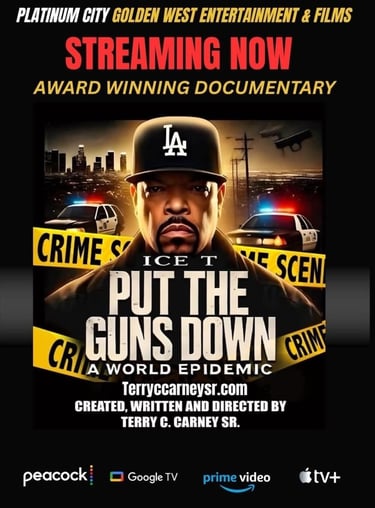Terry C. Carney, A Global Crisis: Overcoming Violence Through Faith
A Global Crisis: Overcoming Violence Through Faith. Join Terry C. Carney on His Mission to "Put the Guns Down."
10/13/20257 min read


A Global Crisis: Overcoming Violence Through Faith. Join Terry C. Carney on His Mission to "Put the Guns Down."
by Terry C. Carney, Sr.
The grim reality of Los Angeles County is often punctuated by reports of gang violence, a constant, low-grade hum of tragedy that seems to affect every corner of the vast urban sprawl. The sheer volume of these stories is staggering, almost numbing, yet there are moments when a single narrative breaks through the noise, demanding attention and affecting one profoundly. This is the case with the story of a young man known only by the poignant nickname, "Gabriel the Angel."
The name itself carries a powerful resonance, immediately evoking the Archangel Gabriel, a figure across several major faiths often associated with communication, revelation, and, critically, healing. This is the Angel of Healing, a divine emissary traditionally invoked for comfort, spiritual recovery, and guidance during times of intense distress, grief, or physical suffering. This deep-seated, spiritual parallel between a figure of hope and a victim of street violence is not merely coincidental; it is a crucial thematic element that underscores the tragic nature of Gabriel’s life. It sets a stage where an individual with a name suggesting divine purpose found himself caught in a brutally earthly conflict.
Gabriel’s narrative, which quickly became a microcosm of the systemic issues plaguing the region, did not unfold in a slow, inevitable decline, but began on a single, seemingly ordinary and ultimately fateful afternoon. The backdrop for this beginning was the city of Compton, a place whose very name has become synonymous with both cultural resilience and chronic, deep-seated poverty and gang warfare. It was within this crucible of ambition and danger, against the familiar, worn landscape of the city streets, that the events defining "Gabriel the Angel’s" story were set irrevocably in motion.
The day that irrevocably altered Gabriel's life began like any other, filled with the routine rhythm of high school and the physical exhaustion of football practice. It was approximately 3:00 PM when he finally finished, his muscles aching with the pleasant fatigue of hard work, and he settled down to wait for his ride home. He stood near the edge of the school grounds, mind perhaps already drifting toward dinner or homework, when two seemingly innocuous men approached him.
They struck up a casual conversation, their initial request being a simple one: directions. Gabriel, a polite and helpful young man, immediately began to assist the first man, pointing out landmarks and giving clear instructions. It was in that moment of distraction, as his focus was entirely on being helpful, that the unimaginable happened. The second man, without warning, pulled a gun and fired a single, devastating shot directly at Gabriel's head. The sheer force and impact of the gunfire were horrific, causing irreparable and immediate damage: both of Gabriel’s eyes were completely blown out of their sockets. In a move of shocking depravity and cold calculation, the criminals then ripped Gabriel’s shirt off his body, not for the cloth itself, but to use it as a makeshift, callous instrument to pick up his dislodged eyes before vanishing into the afternoon chaos.
The initial moments following the attack were a nightmarish blur of disorientation and agony. Gabriel collapsed to his knees, utterly bewildered by the sudden, brutal violence. Unaware of the true severity of his wounds—the loss of his sight—he instinctively began sifting through the dirt around him, perhaps searching for an object, or simply trying to anchor himself in the reality that had just fractured. The chaos quickly drew first responders. When the paramedics and police arrived, they found Gabriel unconscious. Their bedside manner, tragically audible to Gabriel even in his compromised state, was one of resigned finality. He heard the hushed, grim comments among them that suggested he had already succumbed to his injuries, that his life was over. Unbeknownst to the emergency personnel, their every word pierced through the veil of his unconsciousness.
The struggle continued at the hospital. Upon his arrival, the medical staff echoed the bleak assessment of the first responders. Doctors expressed profound doubts about his chances of survival, communicating to the nurses in his presence the painful directive to simply "keep him comfortable until he passed." Surrounded by the voices of despair, lying on a cold hospital bed with the prognosis of imminent death hanging over him, Gabriel found a singular point of resistance. In that ultimate moment of helplessness, he turned inward, away from the fear and the medical finality, and clung to his faith. He engaged in an agonizing, desperate prayer, not for comfort, but for sheer, unyielding strength—pleading with God for the will, the resilience, and the miracle required simply to live.
The recovery Gabriel experienced was truly a testament to the remarkable power of prayer. His healing defied medical expectations, leaving doctors stunned. Despite the inability to restore his eyesight, Gabriel survived this traumatic ordeal, emerging joyful and with a profound, deepened faith in God, whom he praises daily. Adding to his incredible story of resilience and grace, Gabriel has found it in his heart to forgive those who hurt him, and he prays for them every day. He is a living example of warmth and love, touching the lives of everyone he encounters. Gabriel is cherished by all who know him for the light he brings into their lives.
Despite his good fortune in surviving, this incident should never have occurred. Tragically, gun-related homicides in Los Angeles County average around 500 per year. The most recent data indicates that the city of Los Angeles experienced 237 fatal shootings in 2023. Compton recorded 17 fatal shootings in the same year, a figure that, of course, does not account for non-fatal gun violence, such as the shooting that injured Gabriel.
Having spent my formative years in communities impacted by gang activity, I possess an intimate understanding of the challenges associated with survival in the inner city. While I am profoundly grateful for Gabriel's recovery, countless other victims endure physical and emotional trauma or have tragically succumbed to their injuries. This reality was the catalyst for one of the most significant professional collaborations of my career in hip-hop, undertaken with my mentor and esteemed colleague, Ice-T, often recognized as the genre's "Godfather."
Together, we have united for a deeply resonant cause: addressing the critical need to protect children globally from the devastating consequences of indiscriminate gun violence and mental health crises. Our objective is to motivate young individuals toward judicious decision-making, thereby diverting them from the perilous trajectory of taking one another's lives without justification. The chosen vehicle for promoting this change is a docuseries titled Put the Guns Down: A World Epidemic. Our project's message is frequently misinterpreted as an anti-gun stance, condemning gun owners and advocating for the total abolition of firearms. This is not the case. Our core focus is on a critical, yet simple, idea: young people must choose better alternatives than gun violence. When such a choice is made, no one truly wins; one life is lost, and the other person is left a "dead man walking," burdened by the irreversible consequences of a moment's poor decision.
I am convinced that the first episode of Put the Guns Down: A World Epidemic is an essential educational tool. It is specifically designed to illuminate various topics, initiating crucial conversations about issues many are unaware of. This episode aims to spark dialogue between youth and adults, promoting a united approach to address and solve community challenges. Genuine change requires open discussion and collaborative effort toward solutions.
This is a story about a risky solution I have kept to myself for a long time, one that has remained etched in my memory. I am grateful to Jesus for guiding me through it. While I will refrain from mentioning any names, I feel compelled to share the experience.
One early morning, around 3:00 AM, a young boy knocked on my door, with a .38 special revolver hanging at his side. As I opened the door, uncertainty flooded my mind; I was unsure of his intentions and if he posed a threat. However, in that moment, a profound sense of healing and protection enveloped me, prompting me to engage him in conversation.
I invited him to sit in some chairs on my front lawn and, as we talked, I discovered that he had not come to harm me but rather needed someone to talk with. It became clear that God had sent him to me for a reason. The young man was in a dark place, contemplating suicide that very morning. We spent hours together, sharing tears and heartfelt discussions. I embraced him and offered encouragement, urging him to reconsider death.
From that day forward, I took on the role of a mentor and big brother, supporting him as he transformed his life. He eventually enrolled in college, earned an engineering degree, and graduated with distinction, now thriving in his career. This experience reinforced my belief in the motto “reach one, teach one,” emphasizing the importance of active listening and being a vessel for Christ’s love.
Had this boy gone to the wrong house, his life may have ended abruptly, by someone’s fear of him or by his own hand. Mental health is Real. Imagine the many years of growth, success, and love he might never have experienced. There has to be more to life than dying young. The great need continuously inspires me to seek the necessary funding to move forward with the production of the next eleven episodes of this docuseries.
Our mission extends far beyond mere entertainment. Put the Guns Down: A World Epidemic features no actors. Instead, this film captures the raw and authentic experiences of real people, emphasizing that these are not mere stories but the lived realities of those affected by senseless decisions. It is an eye-opening educational tool that must reach every middle school, high school, college, and community worldwide.
The movement has already garnered substantial support. Many people, desperately eager for change, are uncertain about how to start. Therefore, we invite everyone to participate by watching our film Put the Guns Down: A World Epidemic with family, friends, colleagues, and community members. Together, we can save lives and ensure that individuals receive the help they desperately need.
Stream on platforms such as Amazon Prime, Apple TV, and Google.
Check it out on Prime Video
For more information, go to www.terryccarneysr.com.



